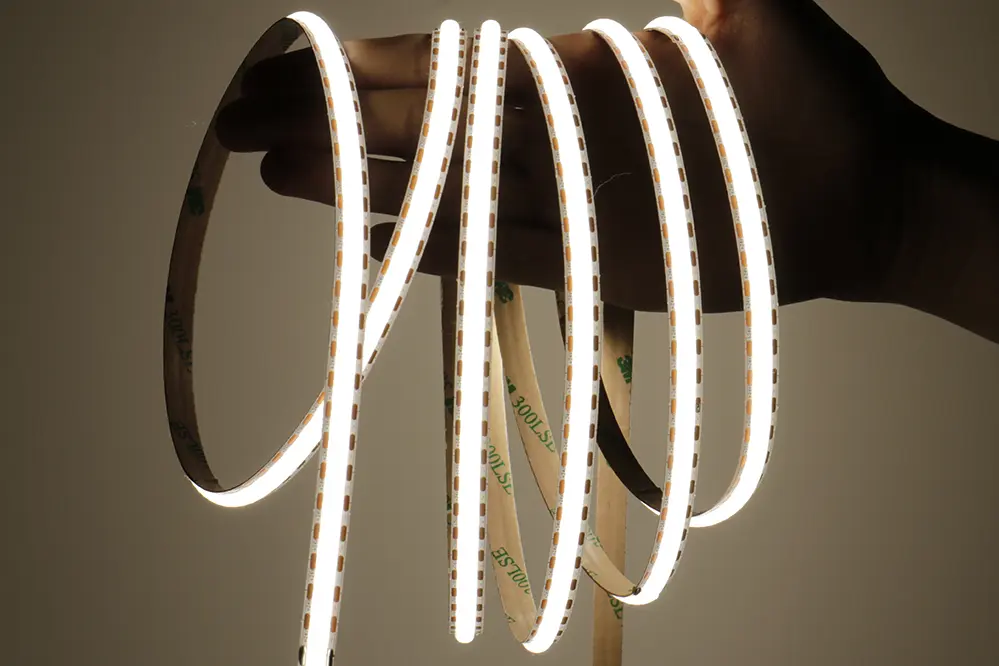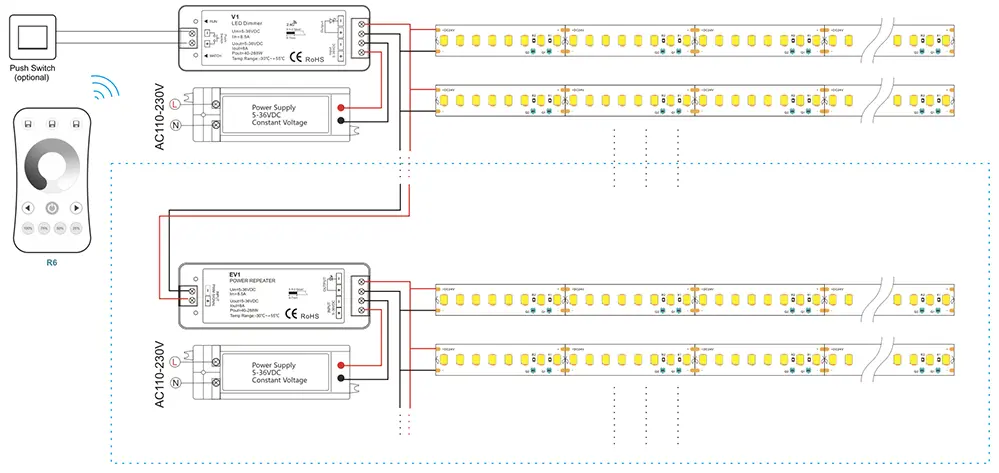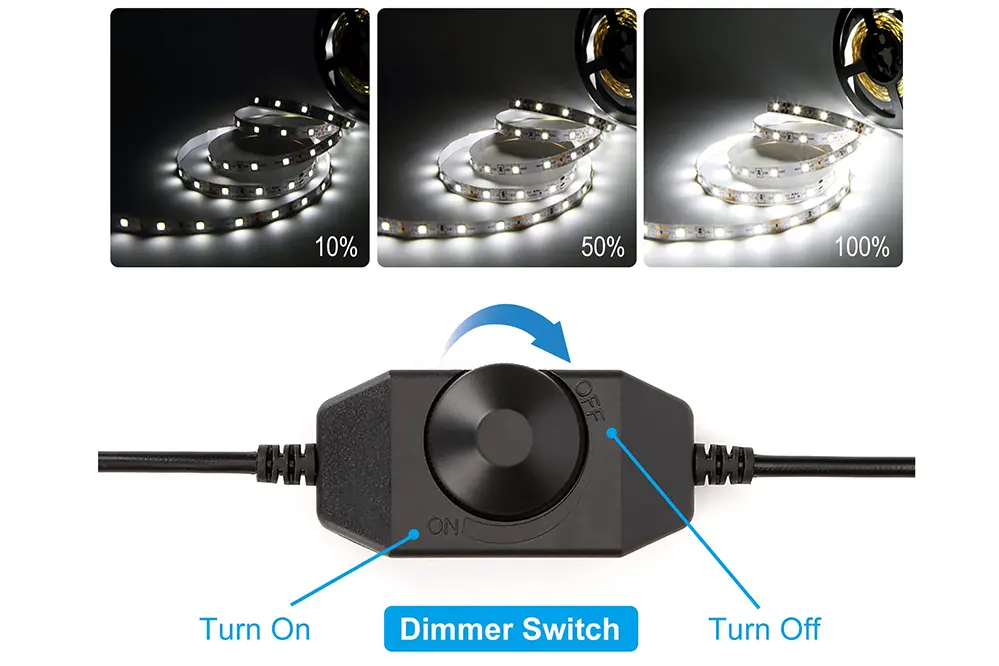Many homeowners face the challenge of creating the perfect ambiance in their living spaces, and incorporating LEDs can be an excellent solution. Knowing how to choose dimmable LED strip lights with high CRI, appropriate lumen levels, the right wattage, and correct voltage spectrum can be the solution to this common problem, offering a versatile and energy-efficient way to enhance any room.
Addressing this issue is crucial, as the right lighting, especially when using LEDs, can significantly impact mood, productivity, and overall well-being. With the rise of LED technology, making an informed choice has never been more important.
There are various solutions available, from understanding different types of LED strips to considering factors like brightness, color temperature, CRI, and ease of installation of LEDs. Each of these elements, including the lumen output and CCT (Correlated Color Temperature), plays a vital role in achieving the desired lighting effect.
Curious about how to make the best choice for your lighting project needs? This article will provide valuable insights and practical tips to help you navigate the world of dimmable LED strip lights, ensuring you create a space that truly shines.
Understand Types of LED Strip Lights

Before choosing dimmable LED strip lights, they must learn about the various types of LEDs available in the market.
Primarily, there are three categories: flexible, rigid, and high-density strips. Flexible strips are highly versatile.
Rigid strips, meanwhile, offer robustness and are often used in linear applications where durability is paramount. High-density strips provide enhanced brightness due to their closely spaced LEDs.
By understanding the distinctions, they can select the type that aligns perfectly with their specific needs and design preferences. Knowledge leads to optimal lighting solutions.
So explore the varieties to find what best suits their lighting ambitions.
Benefits of Dimmable LED Strip Lights
Dimmable LED strip lights using LEDs offer numerous advantages, making them an excellent choice for any environment.
Firstly, the ability to control brightness levels is a significant benefit, enabling users to create unique atmospheres that suit different occasions. Whether they desire a calm, subdued ambiance for relaxation or a bright, vibrant setting for productivity, dimmable lights provide the flexibility needed to achieve these objectives.
Furthermore, dimmable LED strip lights and other LEDs can contribute to energy savings. By adjusting the brightness to low levels when full illumination isn’t necessary, users can reduce energy consumption and lower their electricity bills. This not only enhances sustainability efforts but also promotes long-term cost savings.
Additionally, the extended lifespan of LEDs is maximized through dimming. Lowering the intensity of the lights reduces wear and tear on the components, helping to prolong their operational life. As a result, investing in dimmable LED strip lights is a smart, eco-friendly, and financially sound decision.
How to Choose Dimmable LED Strip Lights

Selecting the perfect dimmable LED strip lights is a multi-faceted task that involves several key considerations.
To begin, they should assess the desired brightness levels, measured in lumen, to ensure the chosen lights sufficiently illuminate the intended space without overpowering it. Next, they should examine compatibility with existing dimmers or smart control systems, as not all LED strip lights are universally compatible with all dimming technologies.
Factors like “color temperature” and “color rendering index (CRI)” are also instrumental in making the ultimate selection.
Assess Your Lighting Needs
Begin by determining the primary purpose of the lighting, whether it be for ambiance, task lighting, or highlighting particular features. This clarification will guide further decisions.
Considering the area’s usage and the time of day when lighting is most necessary can significantly influence whether warm or cool tones are more appropriate.
Properly selecting lighting can reduce energy consumption by up to 75%, enhancing both efficiency and ambiance.
Evaluate factors such as the size of the room and the existing light sources to achieve a balanced illumination for your project. This will help in creating a seamless lighting experience that integrates perfectly with the rest of the space. Importantly, a strategic assessment ensures the lighting aligns with their aesthetic and functional needs.
Evaluate Brightness and Color Temperature
When choosing dimmable LED strip lights, one must understand the significance of brightness and color temperature.
Since 2016, advancements in LED technology have vastly improved, providing consumers with more precision in lighting choices than ever before.
So, it is essential to consider how these lights meet one’s requirements for a specific ambiance or task, effectively enhancing the desired environment.
Taking time to measure the lumens (brightness) required ensures that the desired level of illumination is met, without overwhelming or underwhelming the space.
Combining brightness with the appropriate color temperature (CCT) can transform a room, delivering the perfect balance of aesthetics and functionality.
Check Compatibility with Dimmers
To ensure optimal performance, one must verify that the LED strip lights are compatible with dimmers.
Since LED technology differs from traditional lighting, not all dimmers are suitable for LED strips, requiring careful selection.
Thus, it’s vital to consult the manufacturer’s recommendations to choose a compatible dimmer for the specific LED strip lights they are considering.
Selecting an incompatible dimmer can result in flickering, poor dimming range, or even damage to the lights. Therefore, understanding compatibility is paramount.
Taking these steps will guarantee a smooth, adjustable lighting experience, contributing to a refined and versatile ambiance.
Installation Tips for Dimmable LED Strip Lights

When installing dimmable LED strip lights, the key is to ensure precision for a seamless appearance. Measure the area where the lights will be placed, ensuring that the strips are cut to the correct length, and plan the layout meticulously.
It’s important to clean the surface thoroughly before attaching the strips, as a clean surface ensures better adhesion. Using mounting clips or an aluminum channel can provide added support, preventing sagging over time. Furthermore, proper wiring and secure connections are crucial to avoid interruptions in power flow, ensuring consistent lighting performance and longevity.
Measure and Plan the Layout
The first step in installing dimmable LED strip lights is to measure the area precisely.
By carefully assessing the dimensions of the intended space, individuals can ensure that the LED strips fit perfectly, achieving a polished and professional look. Accurate measurements prevent issues such as gaps or overlaps, which can detract from the seamless visual effect of the lighting. Thus, meticulous planning of dimensions is essential for an aesthetically pleasing result.
Next, they should map out the layout on paper or using design software. Such preliminary visualization helps in identifying potential obstacles and understanding the best routes for the strips, optimizing their placement to enhance the ambiance of the room.
Ultimately, a well-thought-out layout ensures that every inch of the space is utilized effectively, maximizing the impact of the dimmable LED strip lights. This preparatory work lays the foundation for a successful installation, fostering an environment that is both functional and visually stunning.
Properly Attach and Connect
Once the layout has been planned, securing the strips firmly in place ensures longevity and safety.
To achieve this, it is advisable to use a mounting bracket or adhesive tape, depending on the surface. Ensuring the adhesion surface is clean and dry can significantly enhance the hold, preventing detachment due to moisture or dust accumulation.
Additionally, they should create a precise alignment to avoid uneven lighting. By following the pre-planned design, aligning the strips accurately, they guarantee uniformity and symmetry, essential qualities for a professional finish.
Finally, it is critical to correctly connect the strips to the power source and dimmer controls, ensuring that connections are secure and insulated to avoid any electric hazards. Carefully reading and adhering to the manufacturer’s instructions will assist greatly, minimizing the risk of faulty connections and maximizing the longevity and performance of the dimmable LED strip lights.
Maintenance and Troubleshooting
Maintaining dimmable LED strip lights with LEDs is essential to ensure their longevity and performance.
Technological advancements have significantly improved the durability and efficiency of these lights. Regularly checking the connections and ensuring they are secure can mitigate many common issues.
If a light strip fails to dim or flickers intermittently, checking the connections and the power supply should be their first step. Identifying and replacing any faulty segments can solve the problem.
Moreover, ensuring the dimmer switch is compatible with the LED strips is crucial. Incompatible dimmers may cause inconsistent performance, highlighting the importance of cross-checking specifications.
Consistent maintenance and regular inspections ensure these lights provide outstanding performance for years.
Frequently Asked Questions
How can one determine if a dimmable LED strip light is of good quality?
Quality indicators include high lumens per watt, consistent color rendering, and reputable certifications.
Is there a preferred color temperature for indoor use?
Yes, generally 2700K to 3000K is ideal for most indoor settings.
Can all LED strip lights be dimmed?
Not all LED strip lights are dimmable; ensure the packaging specifies dimming capabilities.
What is the lifespan of dimmable LED strip lights?
High-quality dimmable LED strip lights typically last between 25,000 to 50,000 hours.
Are there specific power requirements for dimmable LED strip lights?
Yes, always check the manufacturer’s specifications to ensure the power supply matches the strip’s requirements.
How does one handle installation safely?
Utilize insulated tools, follow manufacturer guidelines, and if unsure, consult a professional electrician for assistance.
Conclusion
Choosing the right dimmable LED strip lights can transform any space, enhancing both its aesthetic appeal and functional utility. By understanding the various types of LED strips, evaluating brightness and color temperature, and ensuring compatibility with dimmers, homeowners can create a customized lighting experience that meets their specific needs. Proper installation and regular maintenance further ensure the longevity and performance of these versatile lighting solutions. With the insights and tips provided in this guide, anyone can confidently navigate the world of dimmable LED strip lights, creating an environment that truly shines.
For those seeking expert guidance and high-quality products, consider reaching out to Unitop, a professional Chinese manufacturer of LED strip lights and LED neon strips. With their extensive experience and commitment to excellence, Unitop offers a wide range of innovative lighting solutions tailored to meet diverse needs. By partnering with a trusted manufacturer like Unitop, you can ensure that your lighting projects are executed with precision and reliability, transforming your space into a beautifully illuminated haven.





